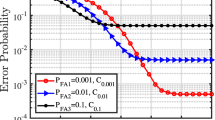Abstract
By using a fair comparison method we show that contrary to the general belief the conventional LMS, when in training mode, does not necessarily outperform the popular blind LMS (BLMS). With the help of a constrained MMSE criterion we identify the correct trained version which is guaranteed to have uniformly superior performance over BLMS since it maximizes the SIR over an algorithmic class containing BLMS. Because the proposed optimum trained version requires knowledge of the amplitude of the user of interest we also present simple and efficient techniques that estimate the amplitude in question. The resulting algorithm in both modes, training and decision directed, is significantly superior to BLMS.
Similar content being viewed by others
References
M. Honig and H.V. Poor, “Adaptive Interference Suppression,” in Wireless Communications: Signal Processing Perspectives, H.V. Poor and G.W. Wornell (Eds.), Upper Saddle River, NJ: Prentice Hall, 1998, Ch. 2, pp. 64-128.
U. Madhow and M. Honig, “MMSE Interference Suppression for Direct Sequence Spread Spectrum CDMA,” IEEE Trans. Commun., vol. COM-42, Dec. 1994, pp. 3178-3188.
U. Madhow, “Blind Adaptive Interference Suppression for Direct-Sequence CDMA,” in Proceedings of IEEE, Oct. 1998, vol. 86,no. 10, pp. 2049-2069.
S.L. Miller, “An Adaptive Direct Sequence Code Division Multiple Access Receiver for Multiuser Interference Rejection,” IEEE Trans. Commun., vol. COM-33, 1995, pp. 1746-1755.
H.V. Poor and S. Verdú, “Probability of Error in MMSE Multiuser Detection,” IEEE Trans. Inf. Theory, vol. 43,no. 2, May 1997, pp. 858-871.
S. Roy, “Subspace Blind Adaptive Detection for Multiuser CDMA,” IEEE Trans. Commun., vol. 48,no. 1, Jan. 2000, pp. 169-175.
J.B. Schodorf and D.B. Douglas, “A Constraint Optimization Approach to Multiuser Detection,” IEEE Trans. Sign. Process., vol. SP-45,no. 1, Jan. 1997, pp. 258-262.
X. Wang and H.V. Poor, “Blind Multiuser Detection: A Subspace Approach,” IEEE Trans. Inform. Theory, vol. IT-44,no. 2, March 1998, pp. 667-690.
Z. Xie, R.T. Short, and C.K. Rushforth, “A Family of Suboptimum Detectors for Coherent Multiuser Communications,” IEEE J. Selec. Areas Commun., vol. 8, May 1990, pp. 683-690.
S. Verdú, Multiuser Detection, New York: Cambridge University Press, 1998.
G.V. Moustakides and H.V. Poor, “On the Relative Error Probabilities of Linear Multiuser Detectors,” IEEE Trans. Inform. Theory, vol. 47,no. 1, Jan. 2001, pp. 450-456.
M. Honig, U. Madhow, and S. Verdú, “Blind Multiuser Detection,” IEEE Trans. Inform. Theory, vol. IT-41, July 1995, pp. 944-960.
A. Benveniste, M. Métivier, and P. Priouret, Adaptive Algorithms and Stochastic Approximation. Berlin: Springer, 1990.
J.A. Bucklew, T.G. Kurtz, and W.A. Sethares, “Weak Convergence and Local Stability Properties of Fixed Step Size Recursive Algorithms,” IEEE Trans. Inform. Theory, vol. IT-39,no. 3, May 1993, pp. 966-978.
G.V. Moustakides, “Locally Optimum Signal Processing Adaptive Estimation Algorithms,” IEEE Trans. Signal Process., vol. SP-46,no. 12, Dec. 1998, pp. 3315-3325.
V. Solo and X. Kong, Adaptive Signal Processing Algorithms, Stability and Performance, Englewood Cliffs, NJ: Prentice Hall, 1995.
S. Haykin, Adaptive Algorithms, 3rd edn., Upper Saddle River, NJ: Prentice Hall, 1997.
R. Lupas and S. Verdú, “Linear Multiuser Detectors for Synchronous Code-Division Multiple-Access Channels,” IEEE Trans. Inform. Theory, vol. IT-35, Jan. 1989, pp. 123-136.
Author information
Authors and Affiliations
Rights and permissions
About this article
Cite this article
Moustakides, G.V. Constrained Adaptive Linear Multiuser Detection Schemes. The Journal of VLSI Signal Processing-Systems for Signal, Image, and Video Technology 30, 293–309 (2002). https://doi.org/10.1023/A:1014019530351
Published:
Issue Date:
DOI: https://doi.org/10.1023/A:1014019530351




